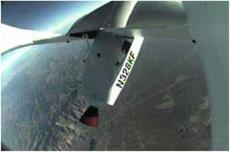Back on Track (7G)
“A stall is when the air flowing over the wing no longer stays attached to the surface. It’s not developing any lift anymore. And as soon as it stalls, you are not an airplane anymore. You are just a 2,000-pound [910-kilogram] lump falling out of the sky,” Mike Melvill defined in Black Sky, the Discovery Channel documentary about SpaceShipOne.
For this flight, the only modifications to each tail boom were the additions of the strake and flow fence. The enlargement of the horizontal stabilizers would wait until the next test flight. However, the new modifications did improve the aerodynamics, and the uncommanded pitch-up of the nose at aft CG was eliminated. Melvill was able to then turn his attention to the feather and rocket-engine controls. Figure 7.8 shows the feather deployed as he continued to push maneuverability limitations.
After the functionality of the rocket-engine instruments and controls checked out, Melvill was ready to land. Figure 7.9 shows a view from the camera mounted in his helmet as SpaceShipOne neared the runway. The glide flight lasted 17 minutes and 49 seconds.
|
|
Ґ ^
Fig. 7.8. Several modifications were put in place to address the stall problem encountered in the previous flight, including the addition of a triangular strake mounted in front of each horizontal stabilizer and a flow fence attached midspan on each horizontal stabilizer. Mojave Aerospace Ventures LLC, video capture provided courtesy of Discovery Channel and Vulcan Productions, Inc.
V___________________ J
г ^ ^
 Fig. 7.9. Flying the first six piloted flights, two captive carries, and four glide flights, Mike Melvill continued to expand the flight envelope. Step by step, he pushed SpaceShipOne to perform a little harder so the engineers could get a more complete picture of its flying qualities. Mojave Aerospace Ventures LLC, video capture provided courtesy of Discovery Channel and Vulcan Productions, Inc.
Fig. 7.9. Flying the first six piloted flights, two captive carries, and four glide flights, Mike Melvill continued to expand the flight envelope. Step by step, he pushed SpaceShipOne to perform a little harder so the engineers could get a more complete picture of its flying qualities. Mojave Aerospace Ventures LLC, video capture provided courtesy of Discovery Channel and Vulcan Productions, Inc.
V____________________________________________________________ )
 |













